
Ring-Billed Gull
November 30th, 2010

Another surprisingly handsome common bird. I like the bright red rings around their eyes.
Common Grackle
November 28th, 2010
Taken on the shore of Mud Lake in late April. A lot of people don't realize how gorgeous grackles are close up and in good light!

1680x1050 wallpaper
King Of Corvids
November 26th, 2010
This raven came along while I was watching diving ducks on Wednesday. He was heralded in the usual way: by the sound of angry crows!

I bet you look at that picture and imagine him making a loud "grawk!", right? Nope. The sound he actually made (repeatedly) was a delicate, hollow little *pop*--like the sound of water droplets. Each time opening his beak wide and fluffing out his throat feathers dramatically, all to deliver this tiny sound effect. Gotta love ravens.

Maybe *pop* was code for, "anybody want to share this?"
A morning on the Rideau (part 2)
November 25th, 2010
The Hooded Merganser is an odd-looking duck at the best of times. So when a wind ruffled this guy's crest feathers, he looked beyond odd--like something had come and taken a bite out of him!

Here he is looking a little more dignified:

"Hoodies" are common spring and fall migrants in Ottawa. They don't usually winter here. Right now you can find them just south of Riverain Park, often swimming right along shore (but you have to peek through the reeds to see them.) Oddly, Hooded Mergansers are known to hybridize, in the wild, with both species of goldeneye. That's not merely a cross-species hybrid, but cross-genus!
A Common Merganser trio:

And one rather disheveled looking Scaup--probably a molting juvenile. This is another late migrant.

A morning on the Rideau (part 1)
November 24th, 2010
It was a great morning for diving ducks on the Rideau today.
For starters, the Goldeneyes are back! Not that this is new news--it's weeks-old news, in fact. But I finally got out there on a sunny morning to take pictures of them.
Most of you have heard me wax eloquent about goldeneyes before, but for the one or two newcomers: Common Goldeneyes are hardy diving ducks who regularly spend the winter in Ottawa, breeding north of us in the boreal forest. They winter on the limited stretches of the Rideau and Ottawa Rivers, usually near rapids, that remain unfrozen year-round. The mature males are black and white with a green gloss to their heads and a white cheek spot; the females are grey and brown.
Like other diving ducks, they submerge entirely underwater in search of food: members of a foraging goldeneye group will disappear and reappear every ten seconds or so, making them an exercise in patience for the bird-watcher! They forage actively even at temperatures of 30 below. They have an incredible tolerance for cold and for rough waters. They are my favorite ducks. I love their beauty and I love their strength.
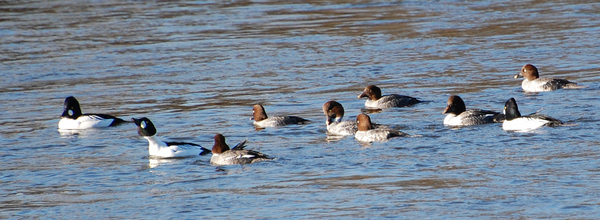
There's even a bit of courtship going on--that's what the male second from the left is up to with the neck-craning. This will continue, probably, until winter really sets in, then they'll resume the festivities in March.
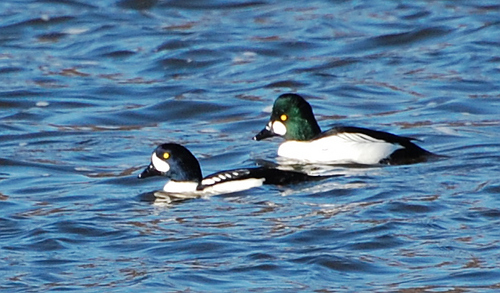
A total of three male Barrow's Goldeneyes have been seen mingling with the Commons. This once-rare species is becoming a more and more regular sight in Ottawa in winter, though they still only come in very small numbers--it's just that they come to predictable spots where birders know to find them. Above is a good comparison of a male Barrow's (front) and Common: you can see the different shape of the cheek spot, and the way the Barrow's' head is glossed with indigo instead of green. (If they weren't well-sunlit, both heads would look black.)
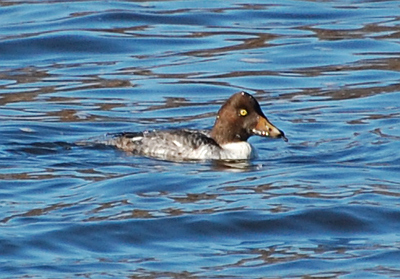
This one's a bit of a mystery. Ordinarily I'd peg it as a juvenile male Common--but if so why the all-yellow bill?
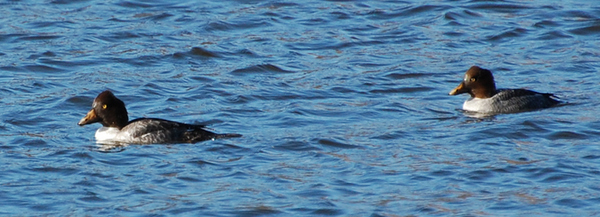
Comparison with female Common (behind).
Something epic
November 22nd, 2010
The backstory is that this snake invaded a woodpecker nest to eat the eggs. The woodpecker was not amused.
This isn't a Pileated; it's a similar species of South America, Crimson-Crested Woodpecker. The footage was taken in Brazil (obviously not by me!)
Common Merganser
November 21st, 2010
Found this female Common Merganser at Riverain Park on Thursday. Her head, bill, and above all feet were startling bits of color on an otherwise gray morning.
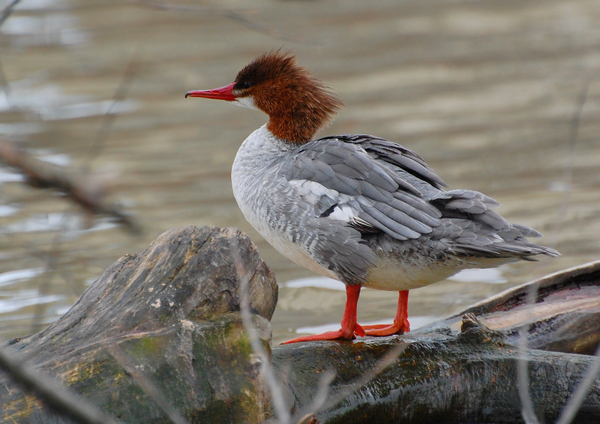
He Of The Flaming Crest
November 20th, 2010
I found this male Pileated Woodpecker drilling some old trees leaning over the Rideau. I often find this species along my stretch of river in November and December.
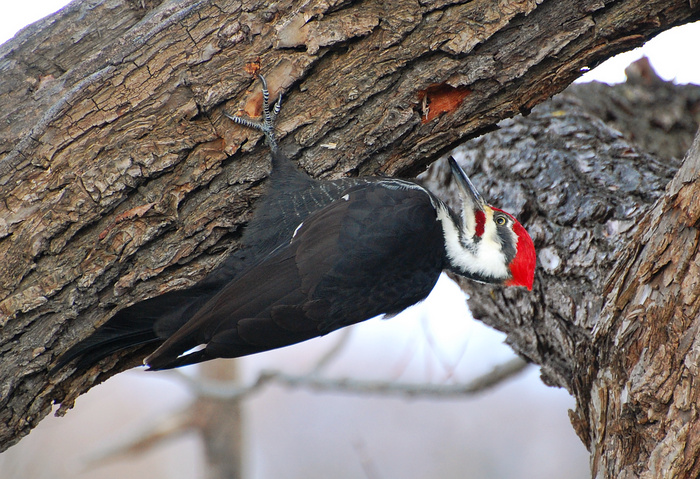
1680x1050 wallpaper
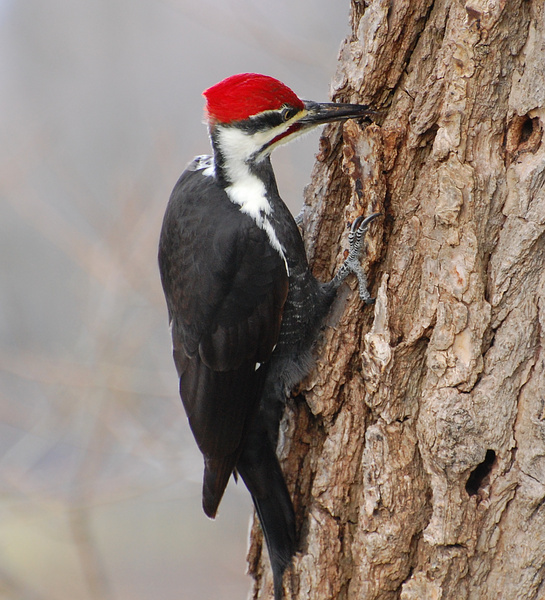
1680x1050 wallpaper
My surrogate backyard
November 18th, 2010
There's a winter bird feeding station about ten minutes walk from where I live, near Hurdman and the Rideau River. It's somewhat established, but often only sporadically maintained. In past years, it's attracted redpolls and siskins--boreal birds who sometimes spend the winter in Ottawa, depending on circumstances in the north (e.g. availability of their favorite foods.)
A big redpoll invasion is predicted for our region this winter. The availability of their favorite northern food, birch seeds, is low, plus, they've had a very successful breeding season, with reports of double and even triple broods. I'm excited about this and eager to see the Hurdman feeders well-maintained to attract them. Not knowing who maintains those feeders or if there's any sort of organized effort, I finally decided to just be proactive! Went to Wild Birds Unlimited, bought a shiny new finch feeder and a bag of nyjer seed (a.k.a. thistle seed), and installed it. Goldfinches, siskins, and redpolls are all closely related, and they all flock together at thistle-seed feeders. So if I establish a goldfinch magnet now, their northern relatives are likely to catch on fast when they arrive.
I had a lot of worries--what you may be forgiven for thinking is a ridiculous amount of neurosis over a bird feeder. Will it survive the weather? Will it survive the squirrels? Will someone be a jerk and steal it? Just how much nyjer seed am I going to be going through? Were the people who installed a finch feeder there in the past (but not, IIRC, last winter) planning on doing it this winter and if so will they feel that I'm stepping on their toes? And, most of all, will the finches come?
...the answer to that last question is yes. Oh my lord, yes.
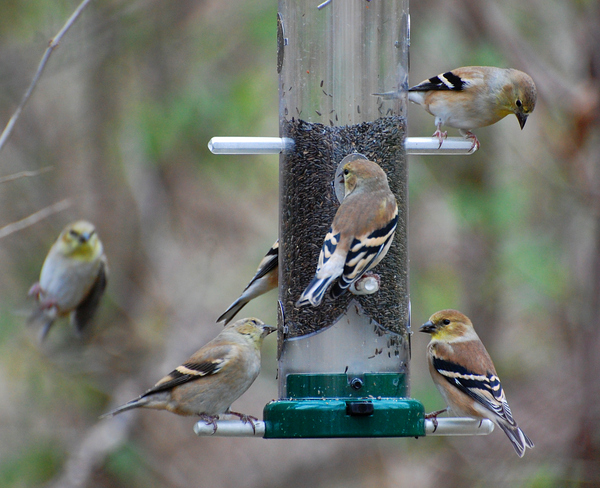
I've got goldfinches. Teeming, swarming goldfinches. Goldfinches enough to deplete a tube full of thistle seed every three days.
My finch feeder is such a success, that There Are Disputes:
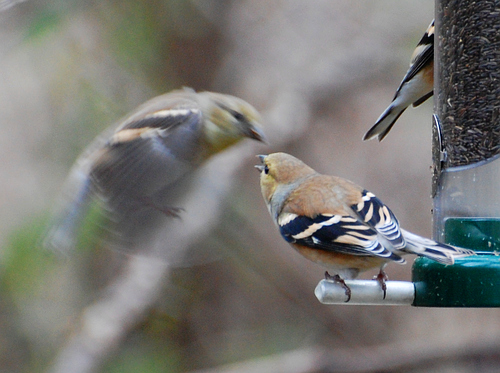
No redpolls yet. But come December or January, there will be redpolls!

Reaction shot: the above photo was taken immediately after a nearby chickadee made an alarm call.
Teal pix
November 2nd, 2010
A rare pleasure: Green-Winged Teal at Stony Swamp! Seemed a good reason to pull my camera out after an extended break.
I only ever see these guys in their fall migration--and then, often, in drab plumage, because the males are late coming out of eclipse. But now they're finished, with their chestnut-brown heads and glittering green cheek stripes. A small number of them have been on the marsh at Jack Pine Trail mingling with the resident mallards. They're not as bold as the mallards, but they're not terribly shy either. If you stand quietly on the boardwalk, they'll eventually swim out into plain view.
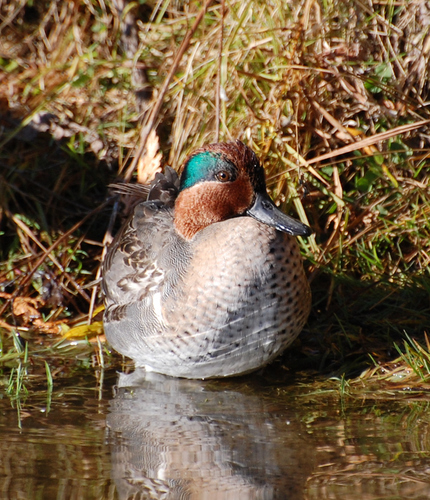

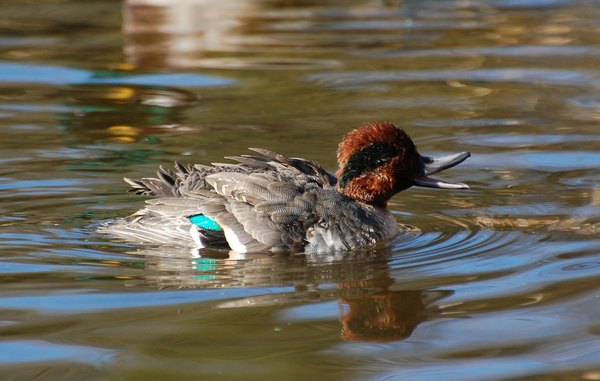
The mallards were exuberant today, zipping and splashing around in a big preen-o-rama. Here, one of the teal gets into the act.
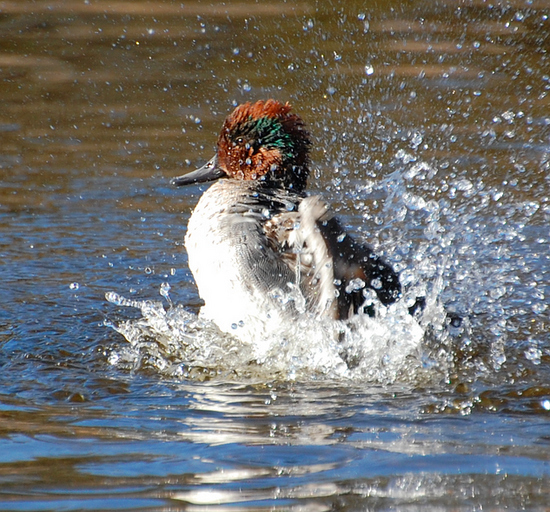
Size comparison with female mallard:

|
